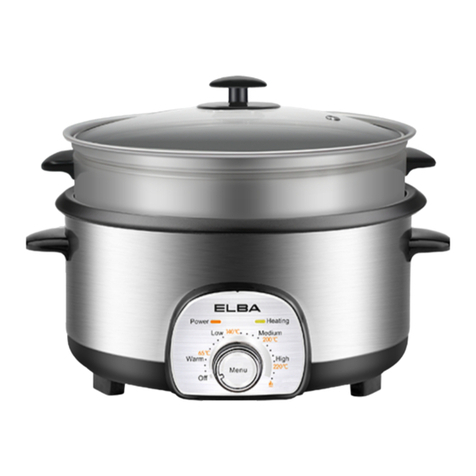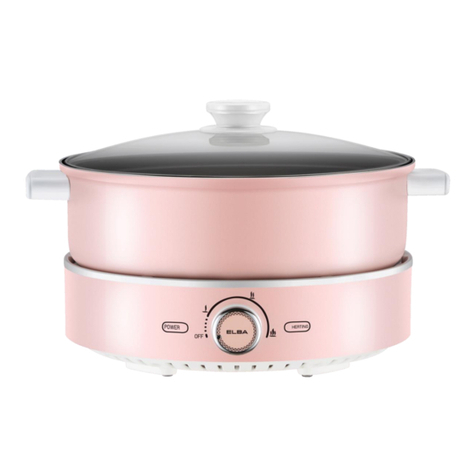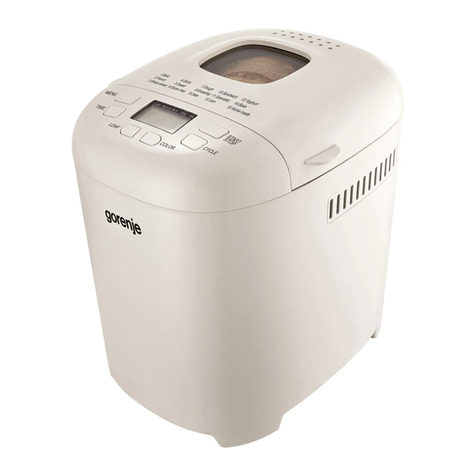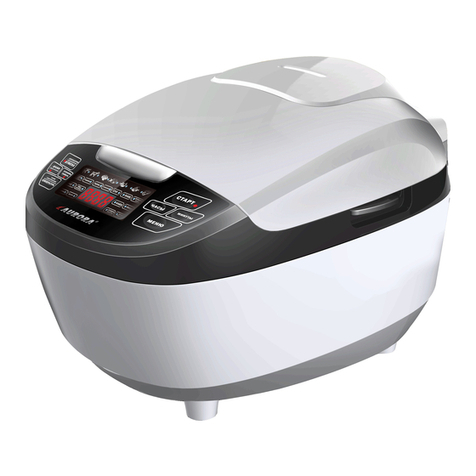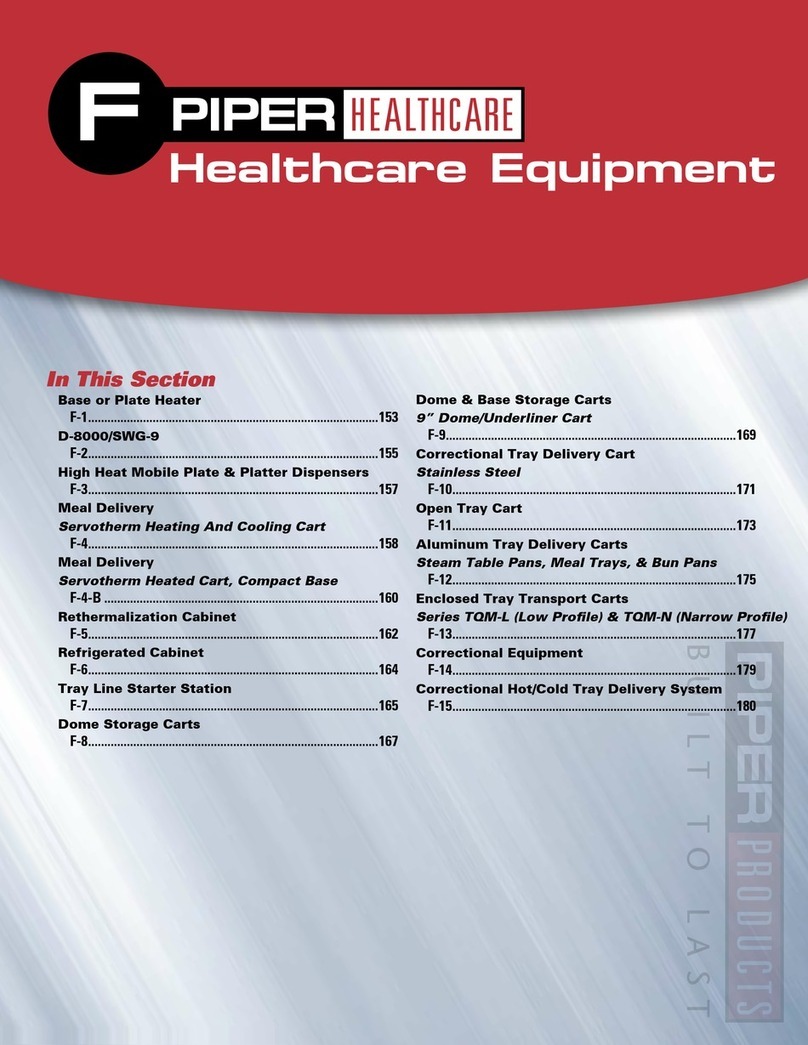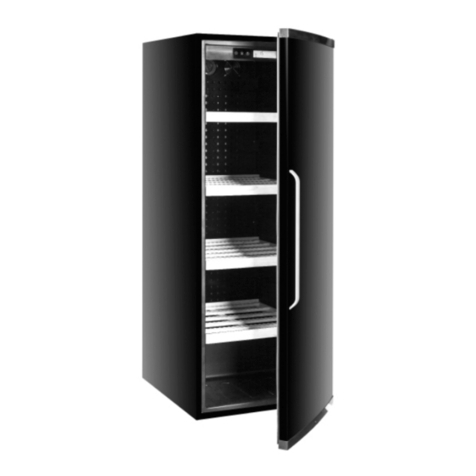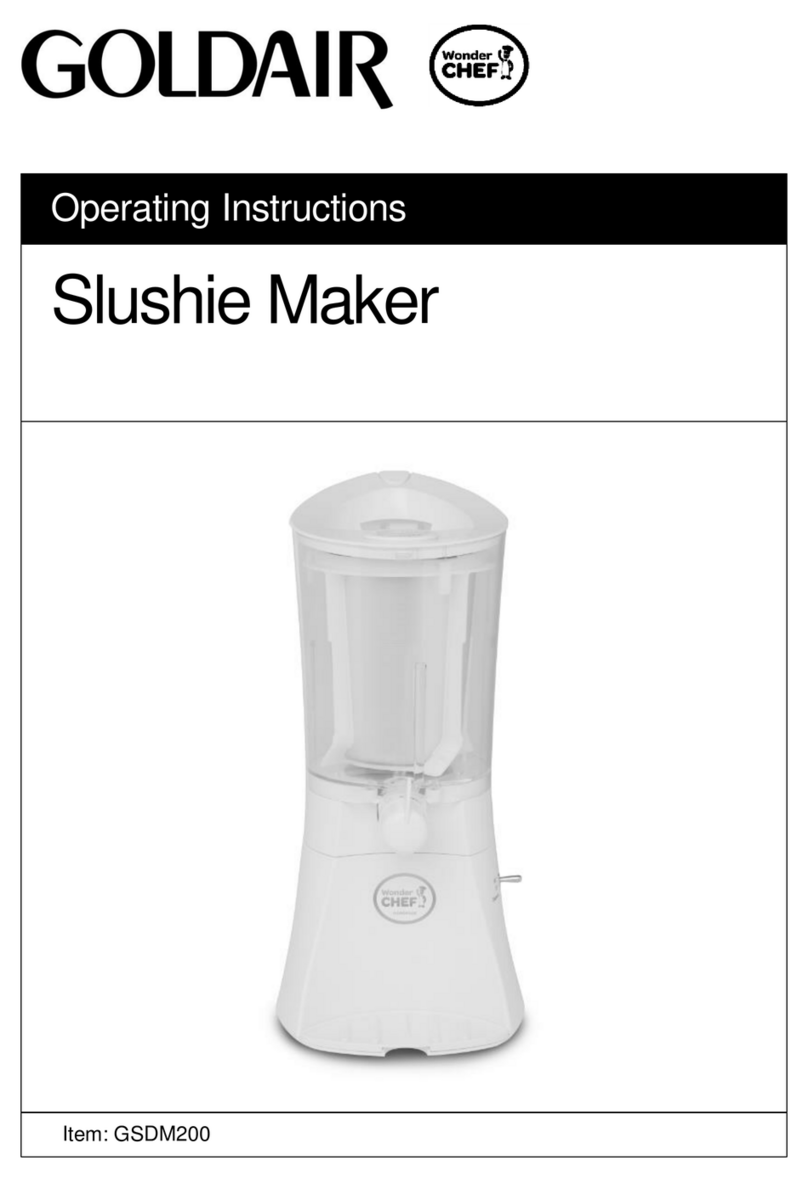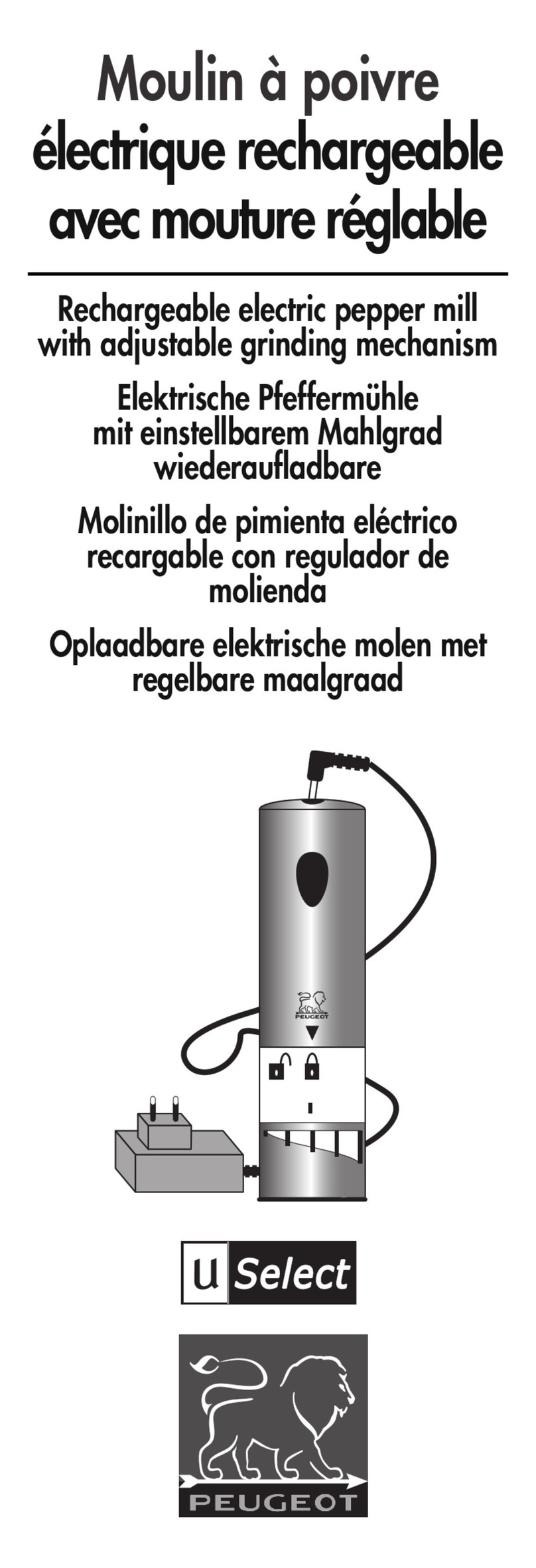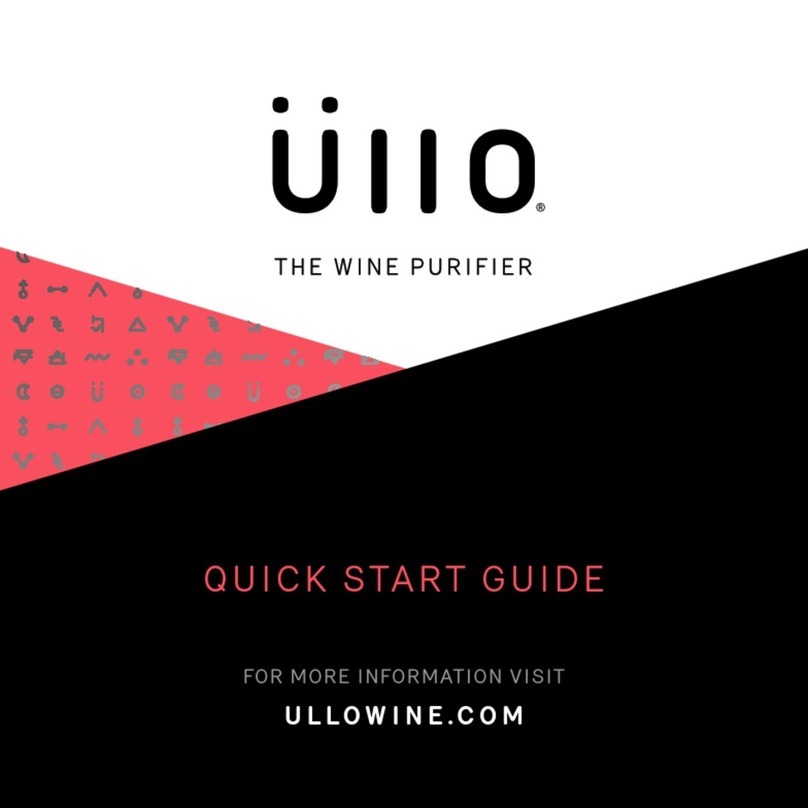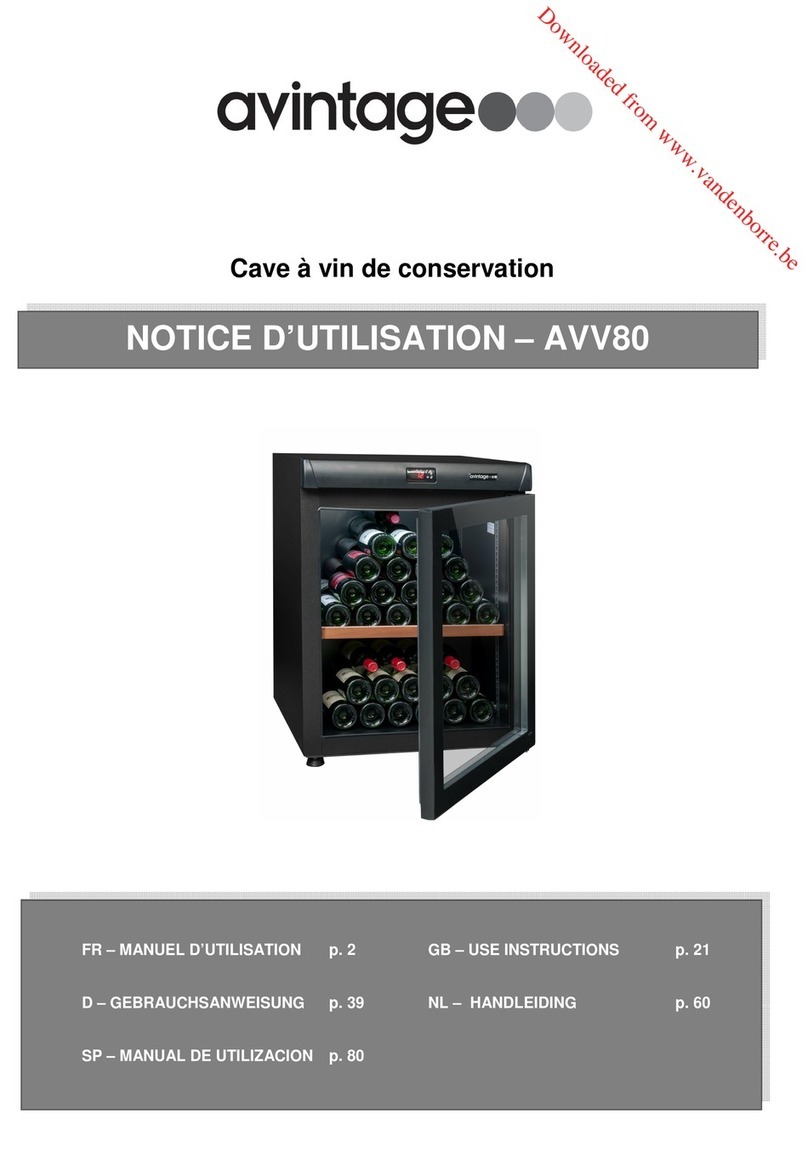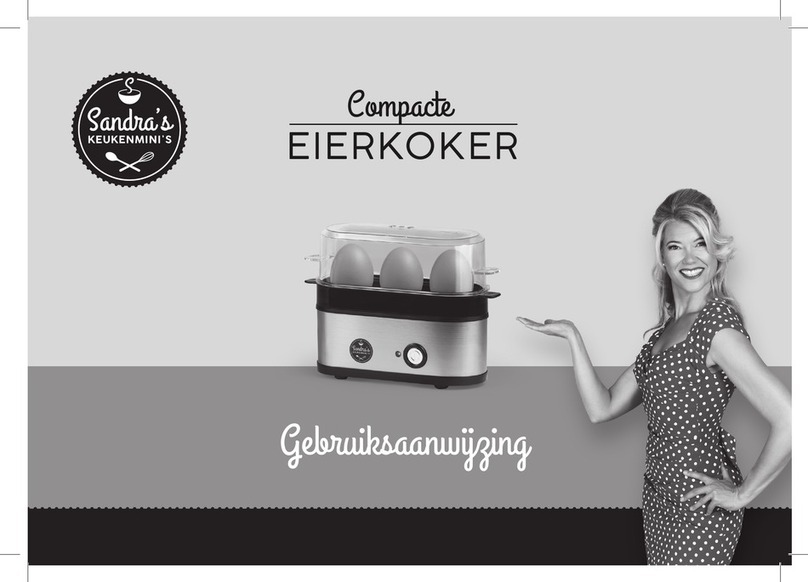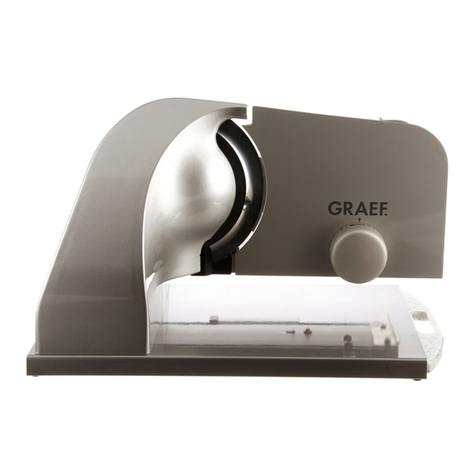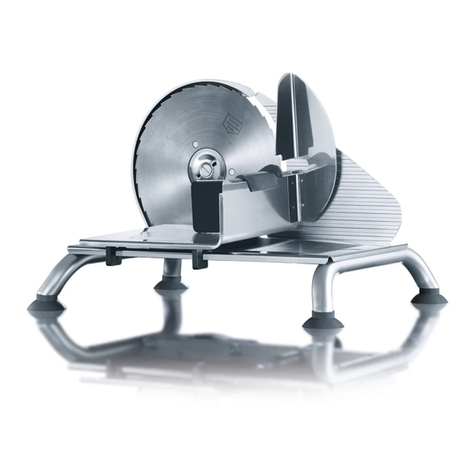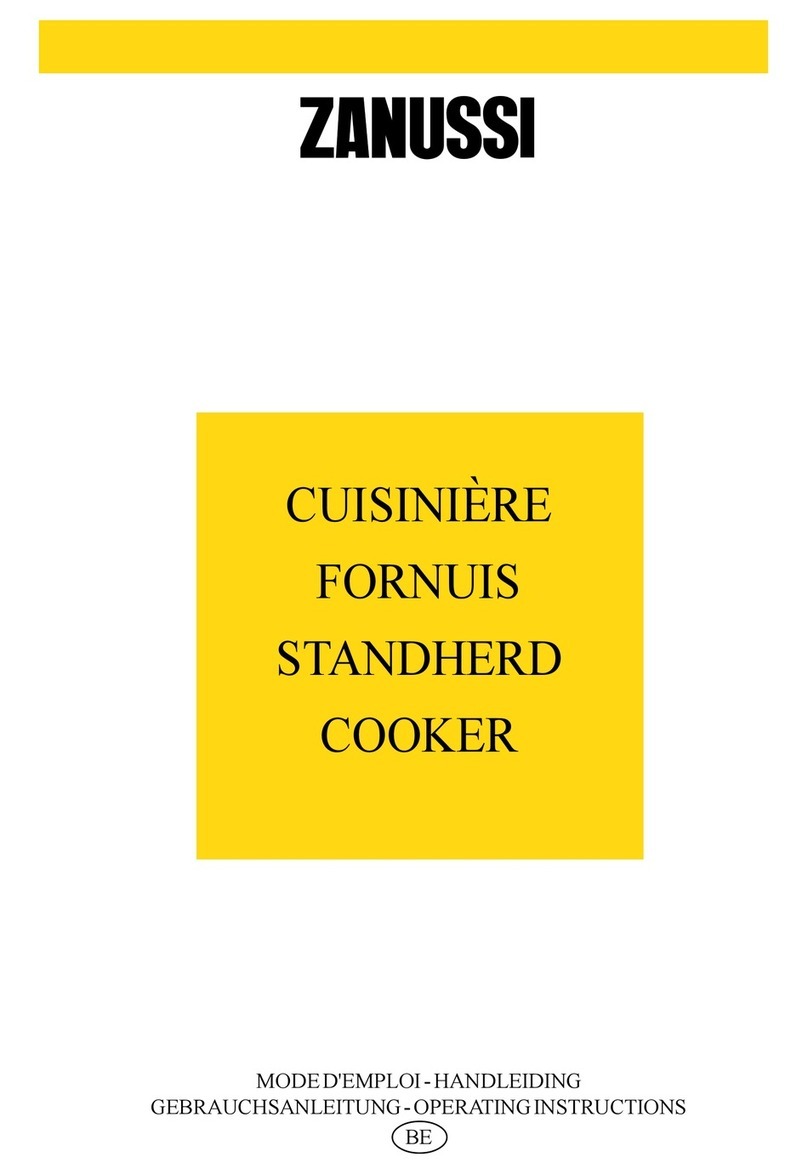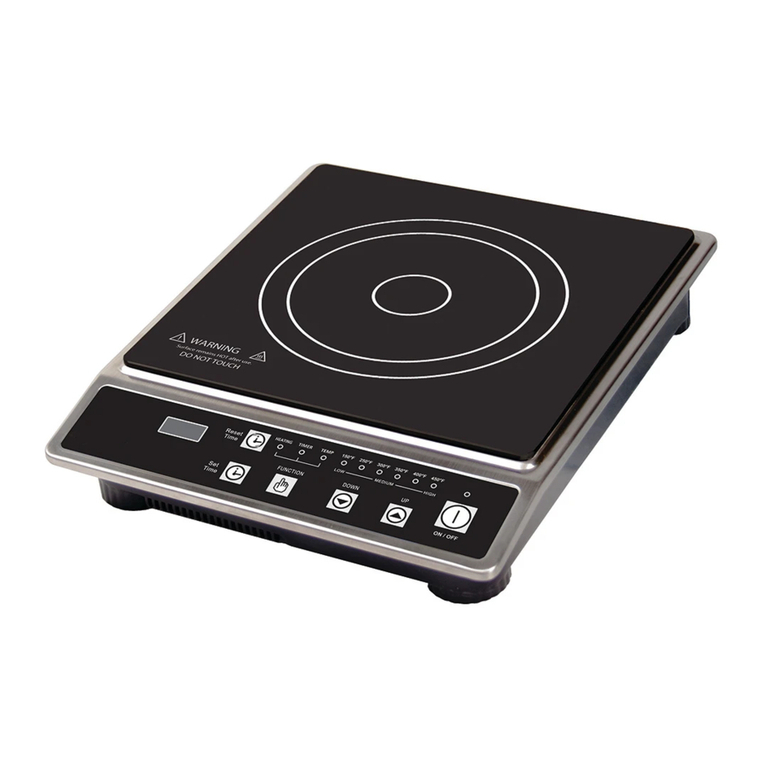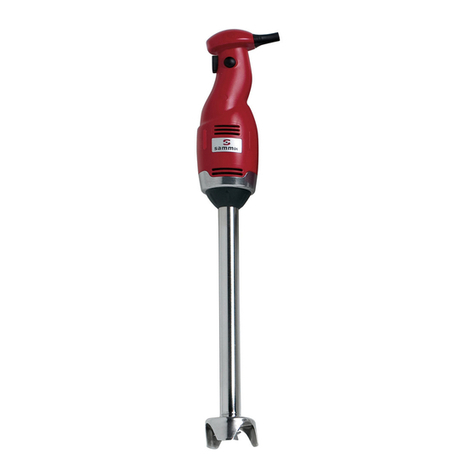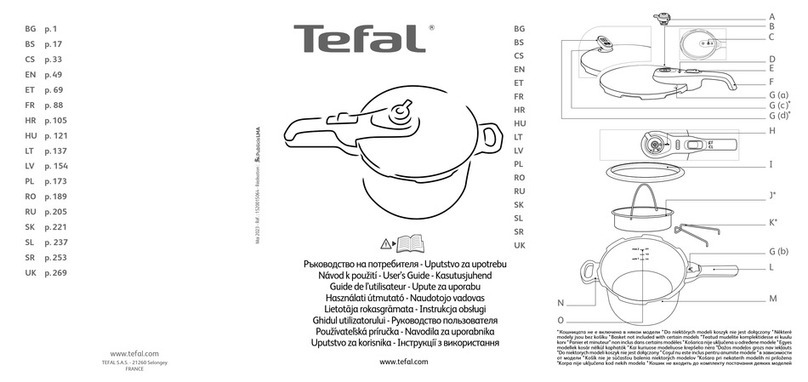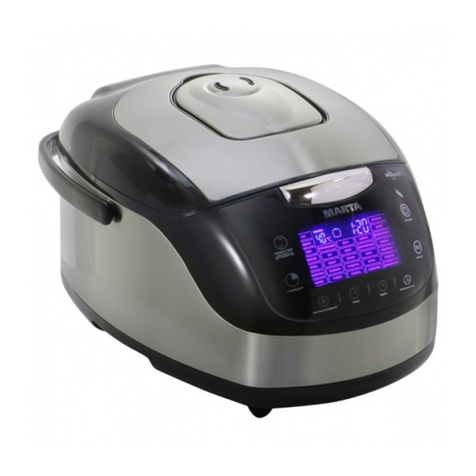Elba N96 EX 939 S Technical manual

Made in Italy
HOME APPLIANCES
10 0%
ELBA QUALITY
MADE IN ITALY
GLASS CERAMIC COOKER
Instructions for the use - Installation advices

2
Dear Customer,
Thank you for having purchased and given your preference to
our product.
The safety precautions and recommendations reported below
are for your own safety and that of others. They will also provide
a means by which to make full use of the features offered by your
appliance.
Please preserve this booklet carefully. It may be useful in
future, either to yourself or to others in the event that doubts
should arise relating to its operation.
This appliance must be used only for the task it has explicitly
been designed for, that is for cooking foodstuffs. Any other
form of usage is to be considered as inappropriate and
therefore dangerous.
The manufacturer declines all responsibility in the event of
damage caused by improper, incorrect or illogical use of the
appliance.

3
IMPORTANT SAFETY PRECAUTIONS AND RECOMMENDATIONS
IMPORTANT: This appliance is designed and manufactured
solely for the cooking of domestic (household) food and is
not suitable for any non domestic application and therefore
should not be used in a commercial environment.
The appliance guarantee will be void if the appliance is used
within a non domestic environment i.e. a semi commercial,
commercial or communal environment.
Read the instructions carefully before installing and using
the appliance.
• After having unpacked the appliance, check to ensure that it is
not damaged and that the oven door closes correctly.
In case of doubt, do not use it and consult your supplier or a
professionally qualied technician.
• Packing elements (i.e. plastic bags, polystyrene foam, nails,
packing straps, etc.) should not be left around within easy reach
of children, as these may cause serious injuries.
• Some appliances are supplied with a protective lm on steel and
aluminium parts. Thislmmustberemovedbeforeusingthe
appliance.
• IMPORTANT: The use of suitable protective clothing/gloves is
recommended when handling or cleaning this appliance.
• Do not attempt to modify the technical characteristics of
the appliance as this may become dangerous to use. The
manufacturer declines all responsibility for any inconvenience
resulting from the inobservance of this condition.
• Do not operate your appliance by means of an external timer or
separate remote-control system.
• Do not carry out cleaning or maintenance operations on the
appliance without having previously disconnected it from the
electric power supply.
• WARNING: Ensure that the appliance is switched off before
replacing the oven lamp to avoid the possibility of electric shock.

4
• Do not use a steam cleaner because the moisture can get into
the appliance thus make it unsafe.
• Do not touch the appliance with wet or damp hands (or feet).
• Do not use the appliance whilst in barefoot.
• If you should decide not to use this appliance any longer (or
decide to substitute another model), before disposing of it, it
is recommended that it be made inoperative in an appropriate
manner in accordance to health and environmental protection
regulations, ensuring in particular that all potentially hazardous
parts be made harmless, especially in relation to children who
could play with unused appliances.
• The various components of the appliance are recyclable. Dispose
of them in accordance with the regulations in force in your country.
If the appliance is to be scrapped, remove the power cord.
• After use, ensure that the knobs are in the off position.
• Children less than 8 years of age shall be kept away unless
continuously supervised.
• This appliance can be used by children aged from 8 years and
above and persons with reduced physical, sensory or mental
capabilities or lack of experience and knowledge if they have
been given supervision or instruction concerning use of the
appliance in a safe way and understand the hazards involved.
Children shall not play with the appliance. Cleaning and user
maintenance shall not be made by children without supervision.
• The manufacturer declines all liability for injury to persons or
damage to property caused by incorrect or improper use of the
appliance.
• WARNING: During use the appliance and its accessible parts
become hot; they remain hot for some time after use.
– Care should be taken to avoid touching heating elements (on
the hob and inside the oven).
– The door is hot, use the handle.
– To avoid burns and scalds, young children should be kept
away.

5
• Make sure that electrical cables connecting other appliances in the
proximity of the cooker cannot come into contact with the hob or
become entrapped in the oven door.
• WARNING: Unattended cooking on a hob with fat or oil can be
dangerous and may result in re. NEVER try to extinguish a re
with water, but switch off the appliance and then cover ame e.g.
with a lid or a re blanket.
• WARNING: Danger of re: do not store items on the cooking
surfaces.
• Do not place or leave empty pans on the glass ceramic hob.
• Do not allow heavy or sharp objects to drop on the glass ceramic
hob.
• Do not scratch the hob with sharp objects. Don’t use the hob as a
work surface.
• WARNING: If the hob is cracked or otherwise damaged by falling
objects etc., disconnect the appliance from the electrical power
supply to avoid the possibility of electric shock and call Customer
Service.
• WARNING: When correctly installed, your product meets all safety
requirements laid down for this type of product category. However
special care should be taken around the rear or the underneath of
the appliance as these areas are not designed or intended to be
touched and may contain sharp or rough edges, that may cause
injury.
• FIRST USE OF THE OVEN - it is advised to follow these instructions:
– Furnish the interior of the oven as described in the chapter
“CLEANING AND MAINTENANCE”.
– Switch on the empty oven on max to eliminate grease from the
heating elements.
– Disconnect the appliance from the electrical power supply, let
the oven cool down and clean the interior of the oven with a
cloth soaked in water and neutral detergent; then dry carefully.
• CAUTION: Do not use harsh abrasive cleaners or sharp metal
scrapers to clean the oven door glass since they can scratch the
surface, which may result in shattering of the glass.

6
• Do not line the oven walls with aluminium foil. Do not place baking
trays or the drip tray on the base of the oven chamber.
• FIRE RISK! Do not store ammable material in the oven or in the
storage compartment.
• Always use oven gloves when removing the shelves and food
trays from the oven whilst hot.
• Do not hang towels, dishcloths or other items on the appliance or
its handle – as this could be a re hazard.
• Clean the oven regularly and do not allow fat or oils to build up in
the oven base or tray. Remove spillages as soon as they occur.
• Do not stand on the cooker or on the open oven door.
• Always stand back from the appliance when opening the oven
door to allow steam and hot air to escape before removing the
food.
• SAFE FOOD HANDLING: Leave food in the oven for as short
a time as possible before and after cooking. This is to avoid
contamination by organisms which may cause food poisoning.
Take particular care during warmer weather.
• WARNING: Take care NOT to lift the cooker by the door handle.

7
Attention! Electrical Shock Hazard.
If the hob is cracked or otherwise damaged by falling objects etc., isolate the cooker from
the power at the fuse / circuit breaker and call Customer Service.
VITROCERAMIC COOKING HOB
1. 3 circuit cooking zone Ø 180 mm 1700 W
2. 3 circuit cooking zone Ø 145 mm 1200 W
3. Oval double cooking zone Ø 145 x 250 mm 1800/1000 W
4. Double cooking zone Ø 210/120 mm 2100/700 W
5. 3 circuit cooking zone Ø 145 mm 1200 W
6. Cooking zones residual heat indicators
OB
2
1
3
4
65
COOKING HOB
1
Fig. 1.1

8
CONTROLS DESCRIPTION
1. Electronic programmer
2. Multifunction oven switch knob
3. Multifunction oven thermostat knob
4. Front left cooking zone control knob
5. Rear left cooking zone control knob
6. Central cooking zone control knob
7. Rear right cooking zone control knob
8. Front right cooking zone control knob
9. Rotisserie control knob
Pilot lamps:
10. Oven thermostat indicator light
11. Ceramic hob ON indicator light
Please note:
This appliance incorporates a safety cooling fan which you will hear operating whenever
the oven or grill are in use.
This fan may continue to run for several minutes after the appliance has been switched off.
This fan is to reduce the external temperature of the appliance and cool the internal
components.
A
U
T
O
P
32 4 5 6 7 8 91
10 11
Fig. 2.1
CONTROL PANEL
2

9
6
5
4
3
2
1
Fig. 3.1
The ceramic surface of the hob allows
a fast transmission of heat in the vertical
direction, from the heating elements
underneath the ceramic glass to the pans
set on it.
The heat does not spread in the horizontal
direction, so that the glass stays “cool” at
only a few centimeters from the cooking
plate.
The 5 cooking zones are shown by painted
disks on the ceramic surface.
Check that the cooker top is clean.
WARNING:
If the surface is cracked, switch
off the appliance to avoid the pos-
sibility of electric shock.
IMPORTANT NOTE:
The heating elements incorporate a
thermolimiter that switches ON/OFF the
element in all settings to protect any
overheating of the ceramic glass.
The use of incorrect pans and/or wrong
pan positioning will cause the temperature
limiter to operate more frequently, resulting
in a reduction of cooking performance.
3 CIRCUIT RADIANT ZONES
Incorporating 3 heating elements (g. 3.2)
you can control and light up all together or
separately by a 6 position switch (g. 3.1).
Reaches the working temperature in a very
short time.
Fig. 3.2
USE OF VITROCERAMIC HOB
3

10
DOUBLE AND OVAL RADIANT ZONES
The heating element is formed of a coil
of resistant material which reaches the
working temperature quickly. Operation
of the cooking zone is controlled by a
continuous energy regulator from “1” to
“12” (maximum temperature) (g. 3.3).
To turn on both zones of the double
element, turn the double element knob fully
clockwise to the position .
To reduce the heat of the full double
element, turn its knob anticlockwise to
setting 12 or lower. Adjust the heat during
cooking as necessary.
Note: if you leave the knob at the
position, the full double element will remain
at the highest heat setting.
To return to using only the inner zone of the
double element, rst turn the knob to the “ “
(off) position (you should feel a click) and
then clockwise to a setting from 1 to 12.
1
2
3
4
5
6
7
8
9
10
11
12
Second element
DOUBLE ZONE
Second element
OVAL ZONE
Fig. 3.5
Fig. 3.4
Fig. 3.3

11
1
2
3
4
5
6
Heating
C ooking
R oasting-frying
1
2
3
4
5
6
7
8
9
10
11
12
Cooking plate
controlled by a 7
position switch
Cooking plate
controlled by a 12
position energy
regulator
TYPE OF COOKING
Switched OFF
For melting operations
(butter, chocolate).
To maintain food hot and to
hea t small quantities of
liquid (sauces , eggs).
To heat bigger quantities ; to
whip c rea ms and s a uc es .
(vegetables , fruits, soups ).
Slow boiling, i. e. : boiled
mea ts , s pa ghetti, s oups ,
c ontinua tions of s tea m
c ooking of roas ts , s tews ,
potatoes.
F or every k ind of frying,
cutlets, uncovered cooking,
i.e.: risotto.
B rowning of meats, roasted
potatoes , fried fis h,
omelettes , and for boiling
large quantities of water.
Fas t frying, grilled s teaks ,
etc.
Switc hing on the s ec ond
element (Double and oval
radiant plates only)
0
K nob
s etting
1
2
3
4
5
6
2
0
1
2
2
3
4
3
4
6
7
47
8
4
5
8
9
10
611
12
After a short period of use, experience will
teach you which setting is the right one for
your needs.
COOKING HINTS
Fig. 3.6

12
RESIDUAL HEAT INDICATOR
The hob also features 5 warning lights
which are connected to the corresponding
plates.
When the temperature of a cooking plate is
above 60°C, the relevant warning light will
also light up to warn of heat on the surface
of the hob.
This light also stay on after the cooking
plate has been switched off to show that
the hob surface is still hot.
This residual heat will lasts for a long time
after the cooking plate has been switched off.
During this time you should avoid
touching the hob surface over the
cooking area.
Please pay special attention to ensure
that children are not allowed near the
hob.
The light will switch off automatically as
soon as the surface temperature of the
cooking plate falls below 60°C.
COOKING HINTS:
• To reduce the cooking time, you can
turn the control knob to the max when
you switch the plate on. After a short
time you can set the control knob to
the position required for cooking.
• You should only use pots and pans
with at bases (pans with the test mark
for glass-ceramic hobs are available
from specialist shops). The diameter
of the pan should match that of the
cooking plate (or be slightly bigger) to
make the most of the energy.
• Since the cooking surface will stays
hot for a certain time after the plate
has been switched off, you can switch
it off 5 or 10 minutes before the end of
the cooking. The residual heat of the
hob will complete the cooking.
• To save electricity, use pan lids
whenever possible.
• Never cook the food directly on the
glass ceramic cooktop.
DEEP FAT FRYING
For safety purposes when deep fat frying,
do not ll the pan more than one hird full
of oil.
DO NOT cover the pan with a lid and
DO NOT leave the pan unattended.
In the unfortunate event of a re, leave
the pan where it is and turn off the control
knobs.
Place a damp cloth or lid over the pan to
smother the ames. Leave the pan to cool
for at least 30minutes before moving the pan.
DO NOT USE WATER ON THE FIRE.
Caution!
the cooking hob becomes very hot
during operation.
Keep children well out of reach.
DO NOT USE GLASS WARE ON CERAMIC HOBS.
DO NOT USE PANS WITH ROUGHT CIRCULAR
MACHINED BASE.
Fig. 3.8
Fig. 3.7

13
ADVICE FOR SAFE USE OF THE
COOKTOP
• Before switching on make sure that you
have the correct knob for the hotplate
chosen. It is advisable to put the pan on
the hotplate before switching on and to
take it away after switching off.
• Use cookware with at and even
bottoms (be careful when using cast
iron vessels). Uneven bottoms can
scratch the glass ceramic surfaces. Be
careful that the bottom is clean and dry.
• Pots with aluminium bottoms may
leave silver streaks or spots on the bob.
• Do not leave wet or damp lids on the
bob.
• The glass-ceramic surface and pans
must be clean. Carefully eliminate any
food remains (especially containing
sugar), dirt etc. with the ai d of a
cleansing agent.
• Make sure that the handles of cookware
do not stick out over the edge of the
cooker, to avoid them being knocked
over by accident. This also makes it
more difcult for children to reach the
cooking vessels.
• Do not lean over the cooking zones
when they are switched on.
• Do not drop heavy or sharp objects
on the glass ceramic cooktop. If the
surface is broken or damaged unplug
the appliance and contact the after-
sales service.
• Do not put aluminium foil or plastic
objects on the cooking zones when
they are hot.
• Remember that the cooking zones
remain hot for some time after they are
switched off (about 30 mm.).
• Follow the cleaning instructions
carefully.
• If you note a crack in the cooktop,
switch the appliance off immediately
and call the After-Sales Service.
Do not scratch the cooktop with
cutting or sharp objects.
Do not use the glass ceramic
surface as a work surface.
CLEANING
Before you begin cleaning make sure
that the appliance is switched off.
Remove any encrustation using a scraper
specic for glass ceramic surfaces.
Dust or food particles can be removed with
a damp cloth.
If you use a detergent, please make sure
that it is not abrasive or scouring.
Abrasive or scouring powders can damage
the glass surface of the hob. All traces of
the cleaner have to be removed with a
damp cloth.
It is highly recommended to keep off the
hob any article which can melt: plastic,
aluminium foil, sugar, sugar syrup mixtures
etc.
If any of these products has melted on
the ceramic surface, you should remove it
immediately (when the surface is still hot)
by using a scraper to avoid any permanent
damage to the surface of the hob.
Avoid using any knife or sharp utensil since
these can damage the ceramic.
Do not use steel wool or an abrasive
sponge which could scratch the surface
permanently.
ATTENTION: MOST IMPORTANT!
If cleaning the glass ceramic hob using
a special tool (i.e. scraper) take extra
care to avoid damage to the seal at the
edges of the glass ceramic surface.
Fig. 3.9

14
Attention: the oven door becomes
very hot during operation.
Keep children away.
GENERAL FEATURES
As its name indicates, this is an oven
that presents particular features from an
operational point of view.
In fact, it is possible to insert 7 different
programs to satisfy every cooking need.
The 7 positions, thermostatically controlled,
are obtained by 4 heating elements which
are:
• Bottom element 1725 W
• Top element 1725 W
• Grill element 2500 W
• Circular element 2500 W
Note:
Upon rst use, it is advisable to operate
the oven for 30 minutes in the position
(thermostat knob on position 175) and
for another 30 minutes at the maximum
temperature (thermostat knob on position
225) in the positions and , to
eliminate possible traces of grease on the
heating elements.
Clean the oven and accessories with warm
water and washing-up liquid.
OPERATING PRINCIPLES
Heating and cooking in the
MULTIFUNCTION oven are obtained in the
following ways:
a. by normal convection
The heat is produced by the upper and
lower heating elements.
b. by forced convection
A fan sucks in the air contained in the
oven mufe, which sends it through
the circular heating element and then
sends it back through the mufe.
Before the hot air is sucked back again
by the fan to repeat the described
cycle, it envelops the food in the
oven, provoking a complete and rapid
cooking. It is possible to cook several
dishes simultaneously.
c. by semi-forced convection
The heat produced by the upper and
lower heating elements is distributed
throughout the oven by the fan.
d. by radiation
The heat is irradiated by the infra red
grill element.
e. by radiation and ventilation
The irradiated heat from the infra red
grill element is distributed throughout
the oven by the fan.
f. by ventilation
The food is defrosted by using the fan
only function without heat.
WARNING:
The door is hot, use the handle.
During use the appliance becomes
hot. Care should be taken to avoid
touching heating elements inside the
oven.
MULTIFUNCTION ELECTRIC OVEN
4

15
THERMOSTAT KNOB
This only sets the cooking temperature and does not switch the oven on.
Rotate clockwise until the required temperature is reached (from 50 to 225°C).
The temperature indicator light signals when the heating elements are switched on or
switched off.
FUNCTION SELECTOR KNOB
Rotate the knob clockwise to set the oven for one of the following functions.
OVEN LIGHT
By turning the knob onto this setting we light the oven cavity.
The oven remains alight while any of the functions is on.
TRADITIONAL CONVECTION COOKING
The upper and lower heating elements are switched on. The heat is diffused by natural
convection and the temperature must be regulated between 50°C and 225°C with the
thermostat knob.
It is necessary to preheat the oven before introducing the foods to be cooked.
Recommended for:
For foods which require the same cooking temperature both internally and externally, i. e.
roasts, spare ribs, meringue, etc.
50
75
100
125
150
1
75
200
2
25
Fig. 4.1 Fig. 4.2

16
GRILLING
The infra-red heating element is switched on. The heat is diffused by radiation.
Use with the oven door closed and the thermostat knob to between 50 and 225°C for 15
minutes, then to position 175°C.
Note: It is recommended that you do not grill for longer than 30 minutes at any one time.
Attention: the oven door becomes very hot during operation. Keep children away.
For correct use see chapter “USE OF THE GRILL”
Recommended for:
Intense grilling action for cooking with a broiler; browning, crisping, “au gratin”, toasting, etc.
DEFROSTING FROZEN FOODS
Only the oven fan is on. To be used with the thermostat knob on “ ” because the other
positions have no effect. The defrosting is done by simple ventilation without heat.
Recommended for:
To rapidly defrost frozen foods; 1 kilogram requires about one hour.
The defrosting times vary according to the quantity and type of foods to be defrosted.
HOT AIR COOKING
The circular element and the fan are on. The heat is diffused by forced convection and the
temperature must be regulated between 50 and 225°C with the thermostat knob.
It is not necessary to preheat the oven.
Recommended for:
For foods that must be well done on the outside and tender or rare on the inside, i.e.
lasagna, lamb, roast beef, whole sh, etc.
VENTILATED GRILL COOKING
The infra-red ray grill and the fan are on. The heat is mainly diffused by radiation and the
fan then distributes it throughout the oven. The temperature must be regulated between
50 and 175°C maximum for max 30 minutes, with the thermostat knob. It is necessary to
preheat the oven for about 5 minutes.
Use with the oven door closed.
It is recommended that you do not grill for longer than 30 minutes at any one time.
Attention: the oven door becomes very hot during operation.
Keep children away.
For correct use see chapter “GRILLING AND COOKING AU GRATIN”.
Recommended for:
For grill cooking when a fast outside browning is necessary to keep the juices in, i. e. veal
steak, steak, hamburger, etc.

17
THAWING AND WARMING UP
The upper element and the circular element connected in series, are switched on; also the
fan is on. The heat is diffused by forced convection with the most heat being produced by
the upper element.
The temperature must be regulated between 50 and 140°C with the thermostat knob.
Recommended for:
To keep foods hot after cooking. To slowly heat already cooked foods.
CONVECTION COOKING WITH VENTILATION
The upper and lower heating elements and the fan turn on.
The heat coming from the top and bottom is diffused by forced convection.
The temperature must be regulated between 50 and 225°C with the thermostat knob.
Recommended for:
For foods of large volume and quantity which require the same internal and external
degree of cooking; for ie: rolled roasts, turkey, legs, cakes, etc.
COOKING ADVICE
Remember to keep children away from the appliance when you use the grill or oven, since
these parts become very hot.
STERILIZATION
Sterilization of foods to be conserved, in full and hermetically sealed jars, is done in the
following way:
a. Set the switch to position .
b. Set the thermostat knob to position 185°C and preheat the oven.
c. Fill the dripping pan with hot water.
d. Set the jars onto the dripping pan making sure they do not touch each other and the
door and set the thermostat knob to position 135°C.
When sterilization has begun, that is, when the contents of the jars start to bubble, turn off
the oven and let cool.
REGENERATION
Set the switch to position and the thermostat knob to position 150°C.
Bread becomes fragrant again if wet with a few drops of water and put into the oven for
about 10 minutes at the highest temperature.

18
SIMULTANEOUS COOKING OF DIFFERENT FOODS
The MULTI-FUNCTION oven set on position and gives simultaneous heterogeneous
cooking of different foods. Different foods such as sh, cake and meat can be cooked
together without mixing the smells and avours.
This is possible since the fats and vapors are oxidized while passing through the electrical
element and therefore are not deposited onto the foods.
The only precautions to follow are:
• The cooking temperatures of the different foods must be as close to as possible, with
a maximum difference of 20- 25°C.
• The introduction of the different dishes in the oven must be done at different times in
relation to the cooking times of each one.
The time and energy saved with this type of cooking is obvious.
ROASTING
To obtain classical roasting, it is necessary to remember:
• that it is advisable to maintain a temperature between 180 and 200°C.
• that the cooking time depends on the quantity and the type of foods.
GRILLING AND COOKING AU GRATIN
Set the switch to position . Set the thermostat to position 175°C and after having
preheated the oven, simply place the food on the shelf.
Close the door and let the oven operate with the thermostat on, until grilling is complete.
Adding a few dabs of butter before the end of the cooking time gives the golden “au gratin”
effect.
Grilling with the oven door closed.
Do not grill for longer than 30 minutes at any one time.
ATTENTION: the oven door becomes very hot during operation. Keep children away.
USE OF THE GRILL
Preheat the oven for about 5 minutes. Introduce the food to be cooked, positioning the rack
as close to the grill as possible.
The dripping pan should be placed under the rack to catch the cooking juices and fats.
Grilling with the oven door closed.
Do not grill for longer than 30 minutes at any one time.
ATTENTION: the oven door becomes very hot during operation. Keep children away.
OVEN COOKING
Before introducing the food, preheat the oven to the desired temperature. For a correct
preheating operation, it is advisable to remove the tray from the oven and introduce it
together with the food, when the oven has reached the desired temperature.
Check the cooking time and turn off the oven 5 minutes before the theoretical time to
recuperate the stored heat.

19
ROTISSERIE
This device is made up of:
• an electrical motor mounted on the
rear part of the oven
• stainless steel spit with a removable
stay-cool handle and two adjustable
sets of prongs
• spit support to be inserted in the
central guide of the oven.
The rotisserie motor is operated by a switch
knob (Fig. 4.3 - position).
The rotation direction of the rotisserie can
be either clockwise or counterclockwise.
USE OF THE ROTISSERIE
• Insert the tray into the lowest rack
holders of the oven and insert the
rod support into the intermediate rack
holders.
• Put the meat to be cooked onto the
rod, being careful to secure it in the
center with the special forks.
• Insert the rod into the side gear
opening “P” (g. 4.4)
• Remove the grip “H” by turning it to the
left.
• Insert completely the rotisserie
support; the shaft “S” must be inserted
in the spit motor collar “G”.
• Close the oven door and switch on
the grill and turnspit. The rotation
direction of the rotisserie can be either
clockwise or counter-clockwise.
Grilling with the oven door closed.
Attention: the oven door becomes very
hot during operation.
Keep children away.
It is recommended that you do not grill
for longer than 30 minutes at any one
time.
G
S
H
P
Fig. 4.4
Fig. 4.3

20
The electronic programmer is a device which groups together the following functions:
• 24 hours clock with illuminated display
• Timer (up to 23 hours and 59 minutes)
• Program for automatic oven cooking
• Program for semi-automatic oven cooking
Description of the buttons:
Timer
Cooking time
End of cooking time
Manual position and cancellation of
the inserted cooking program
To increase the numbers on
the digital display
To decrease the numbers on
the digital display.
Description of the illuminated
symbols:
AUTO - ashing - Programmer in automa-
tic position but not programmed
AUTO - illuminated - Programmer in auto-
matic position with program inser-
ted.
Automatic cooking taking place
Timer in operation
and AUTO - ashing - Program
error.
(The time of day lies between the
calculated cooking start and end
time).
Note:
Select a function by the respective button
and, in 5 seconds, set the required time with
the / buttons (“one-hand” operation).
After a power cut the display resets to zero
and cancels the set programs.
A
U
T
O
Fig. 5.2Fig. 5.1
ELECTRONIC PROGRAMMER
5
Table of contents
Other Elba Kitchen Appliance manuals
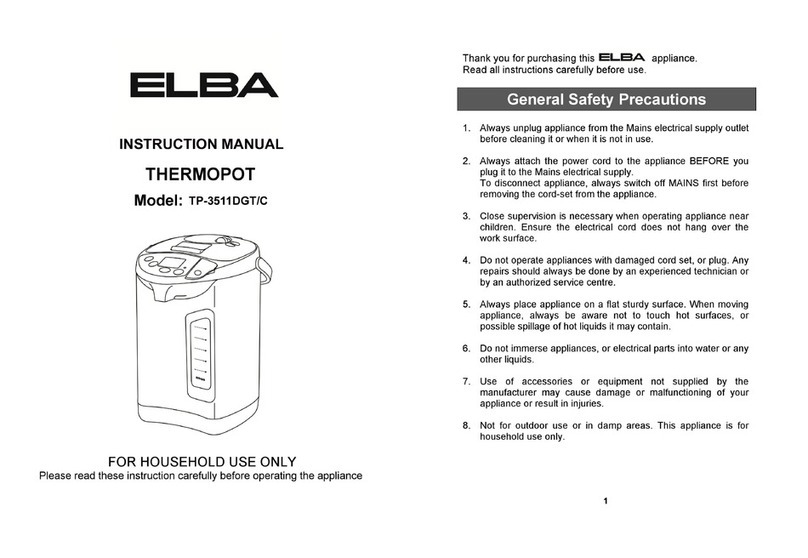
Elba
Elba TP-3511DGT User manual
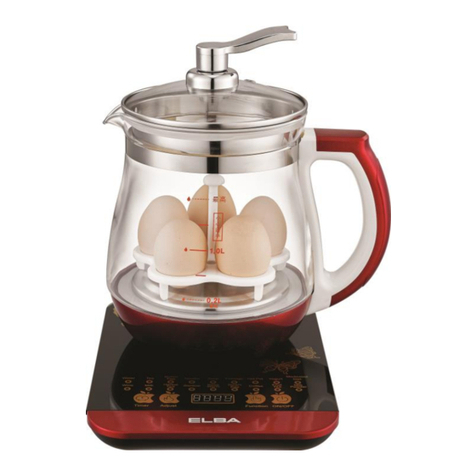
Elba
Elba EHP-G1583G(RD) User manual
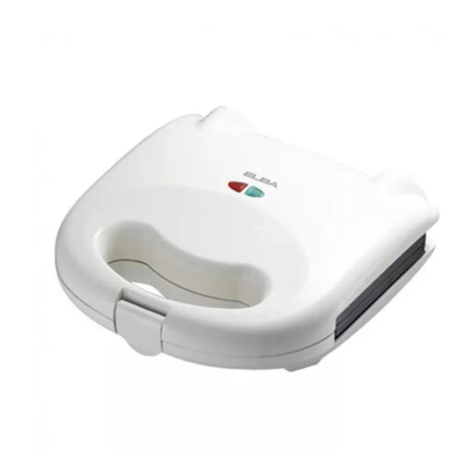
Elba
Elba ESM-2085 User manual
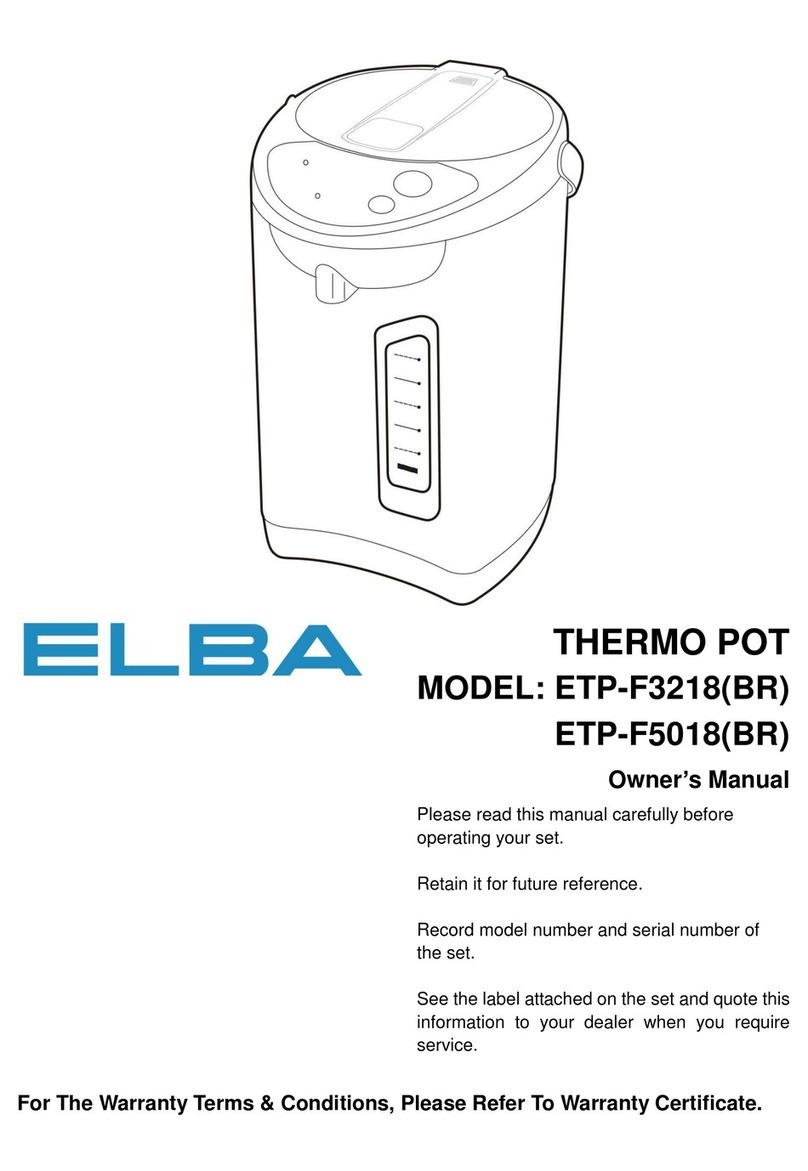
Elba
Elba ETP-F3218 User manual
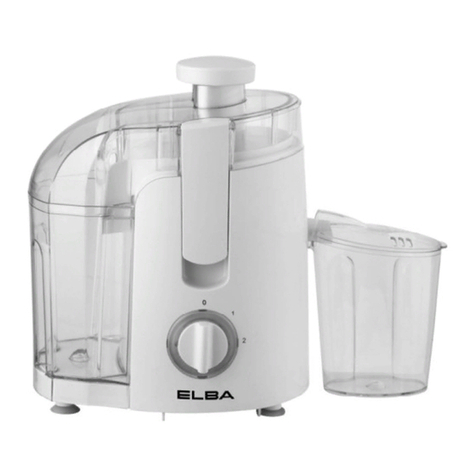
Elba
Elba EJE-A0435 User manual
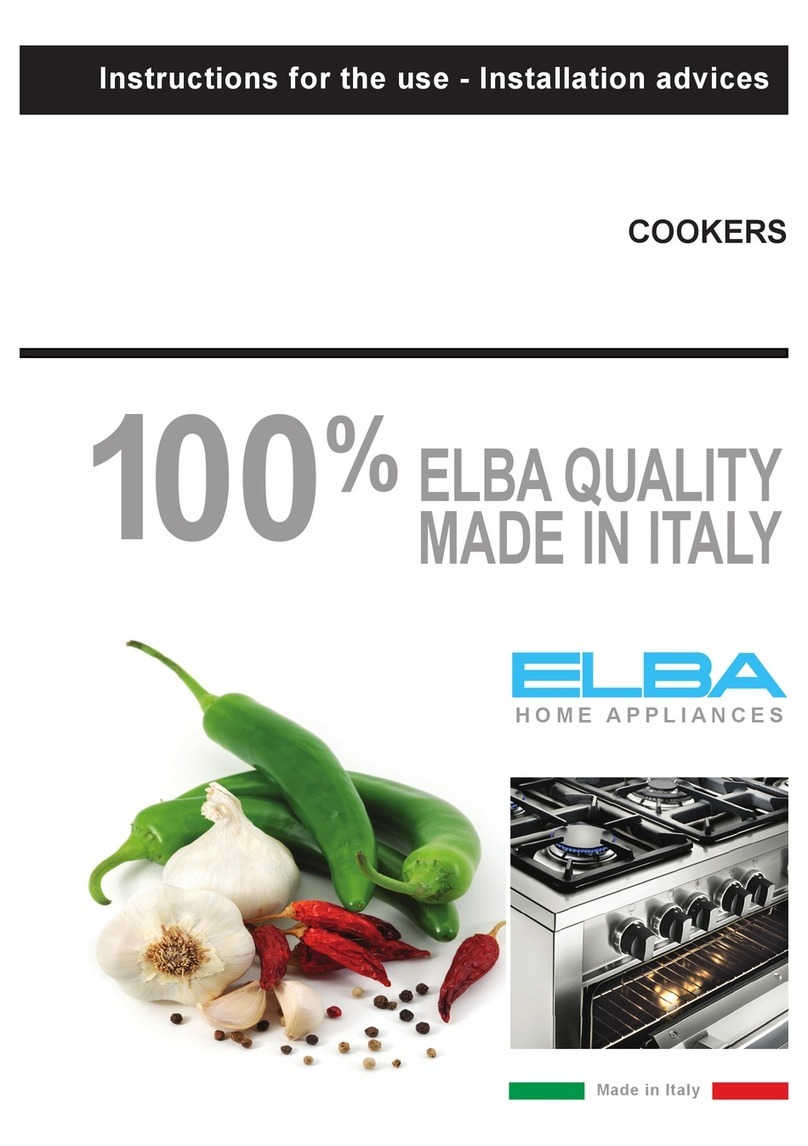
Elba
Elba E K55..220 series Installation and operating instructions
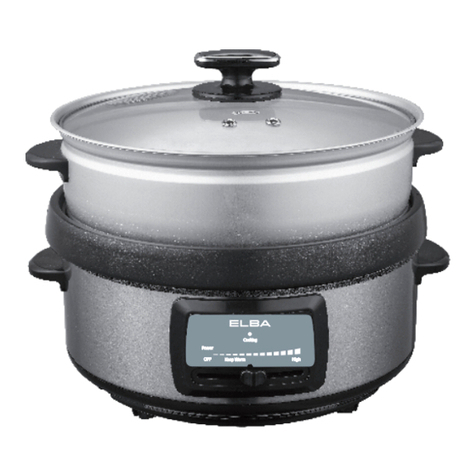
Elba
Elba EMC-F4316 User manual
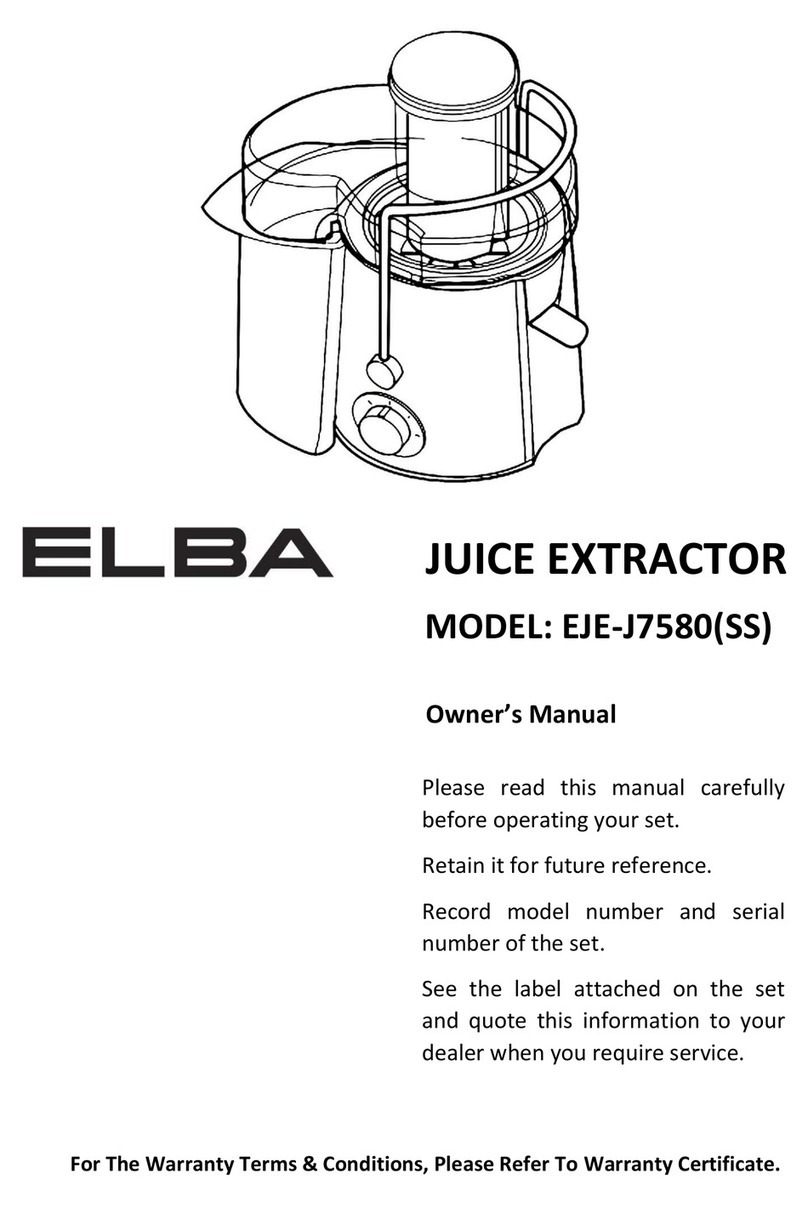
Elba
Elba EJE-J7580(SS) User manual
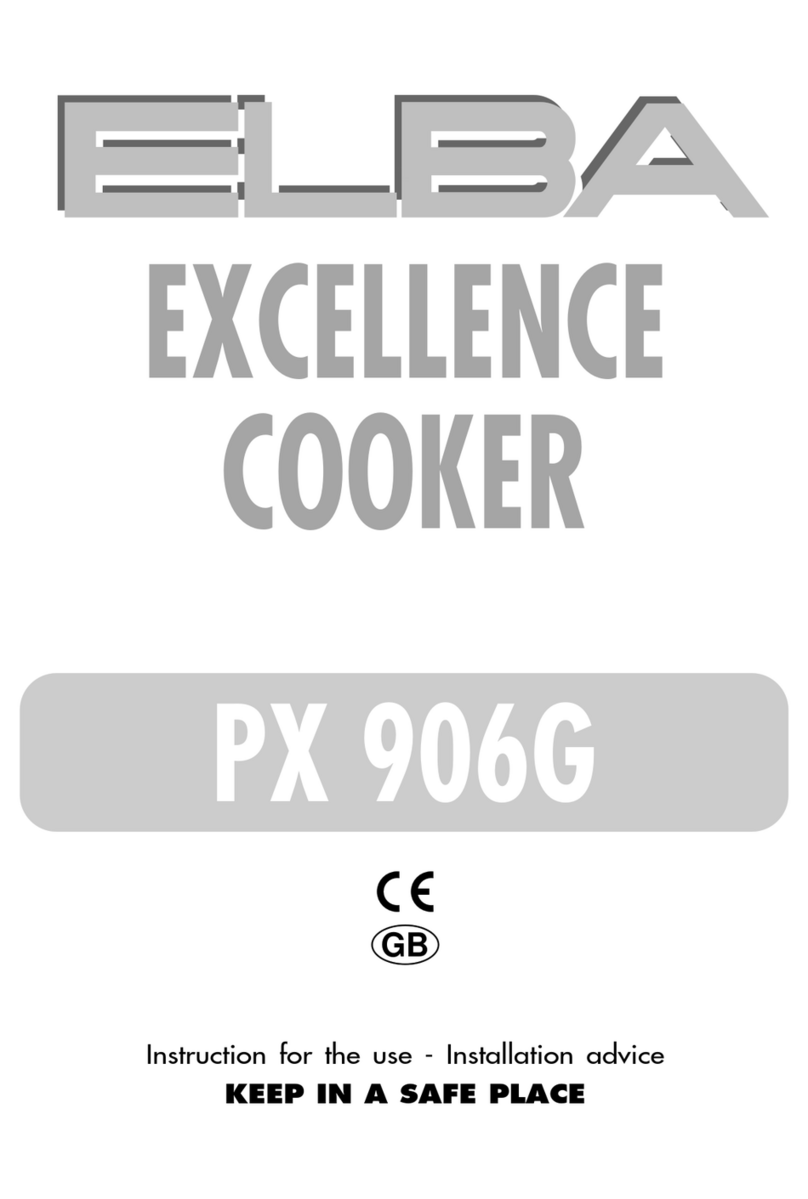
Elba
Elba PX 906G Installation and operating instructions
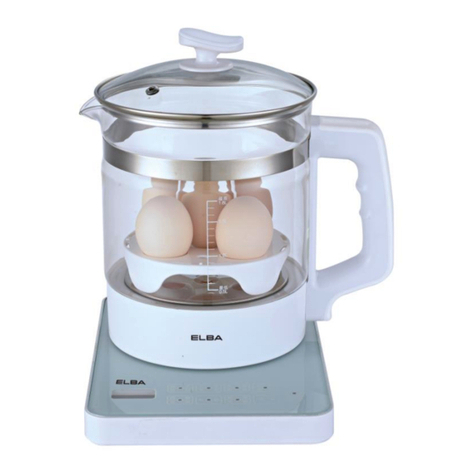
Elba
Elba EHP-E1881G User manual
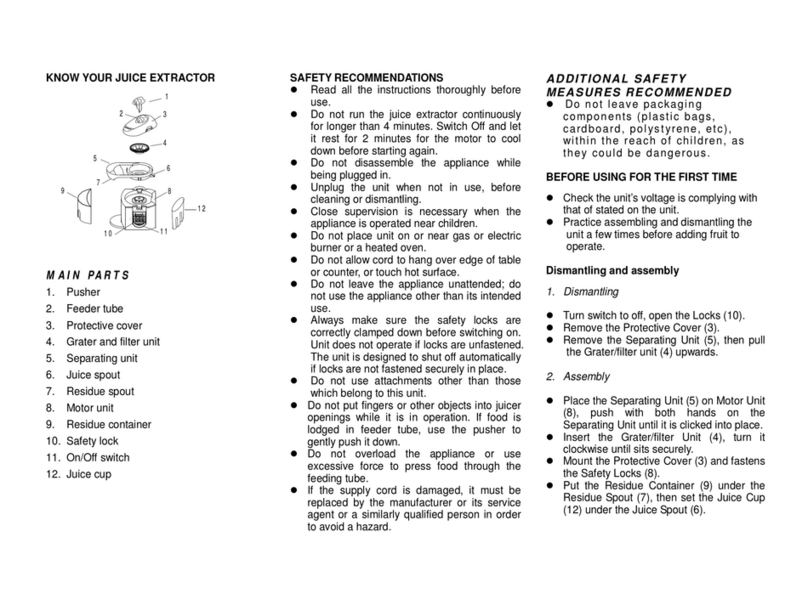
Elba
Elba EJE-1302 User manual

Elba
Elba EJE-9811A User manual
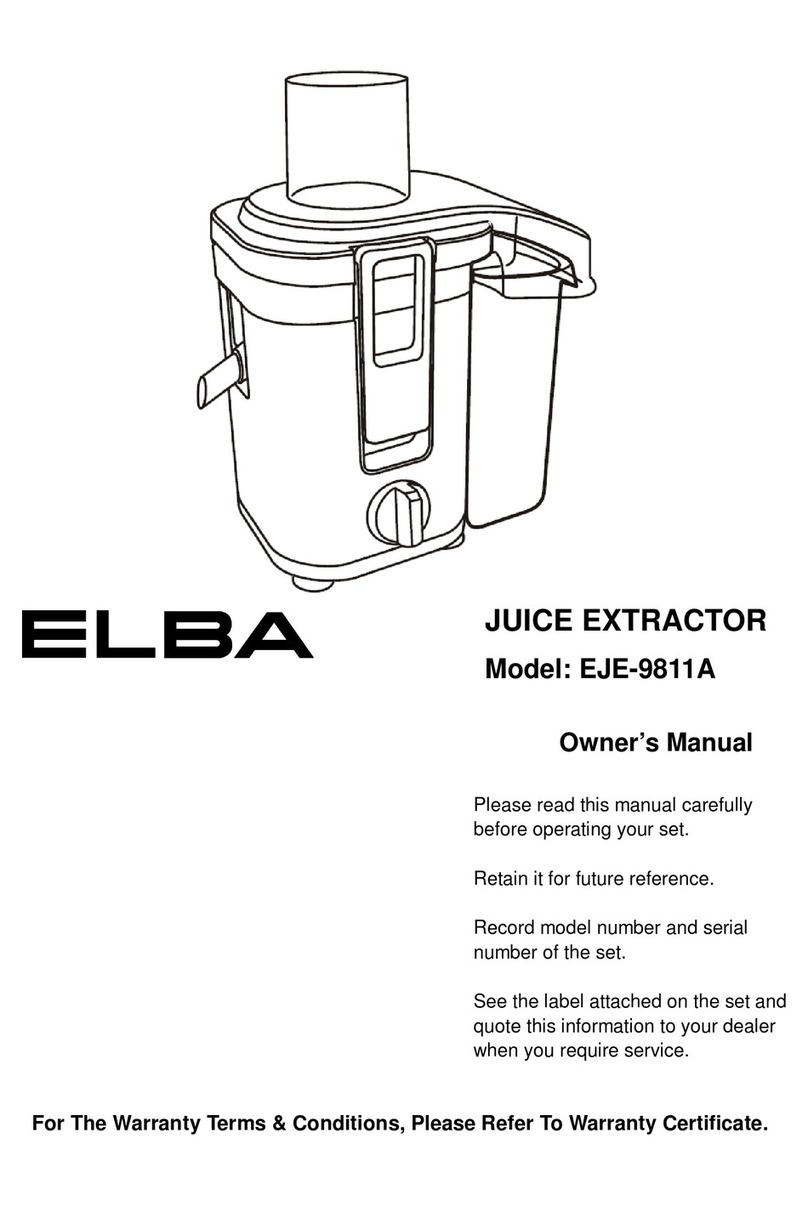
Elba
Elba EJE-9811A User manual
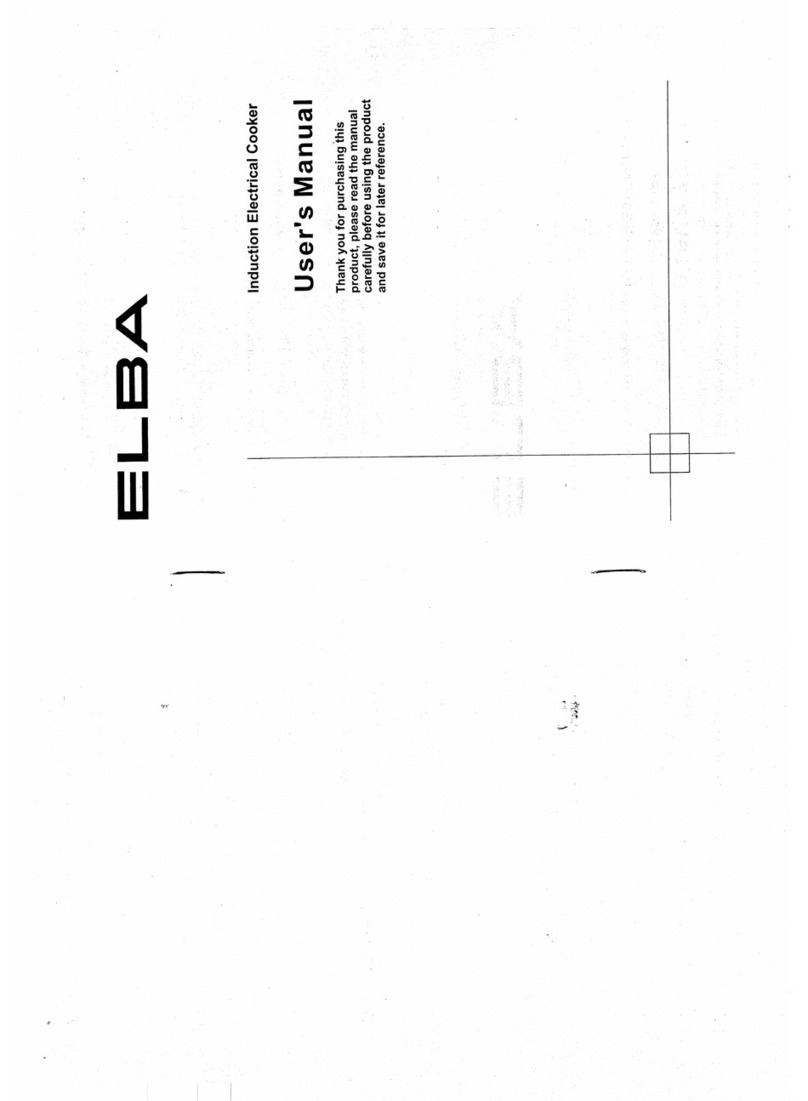
Elba
Elba EIC-1600P User manual
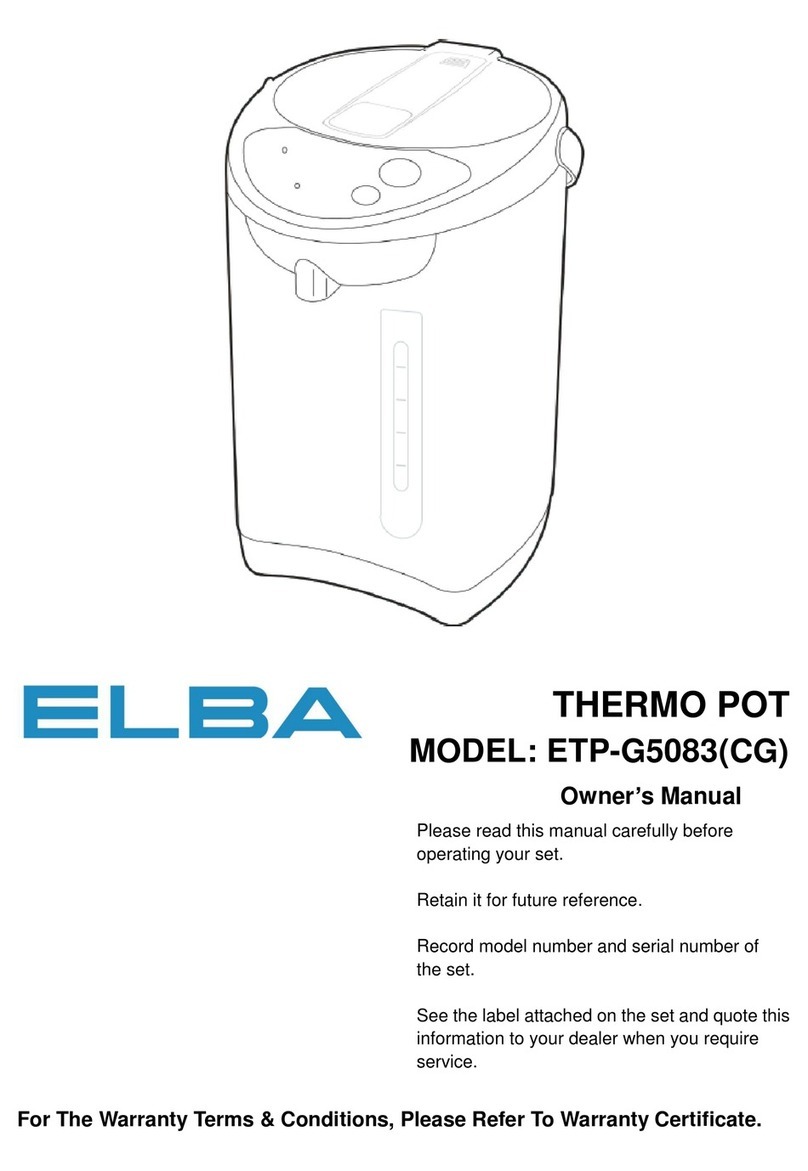
Elba
Elba ETP-G5083(CG) User manual
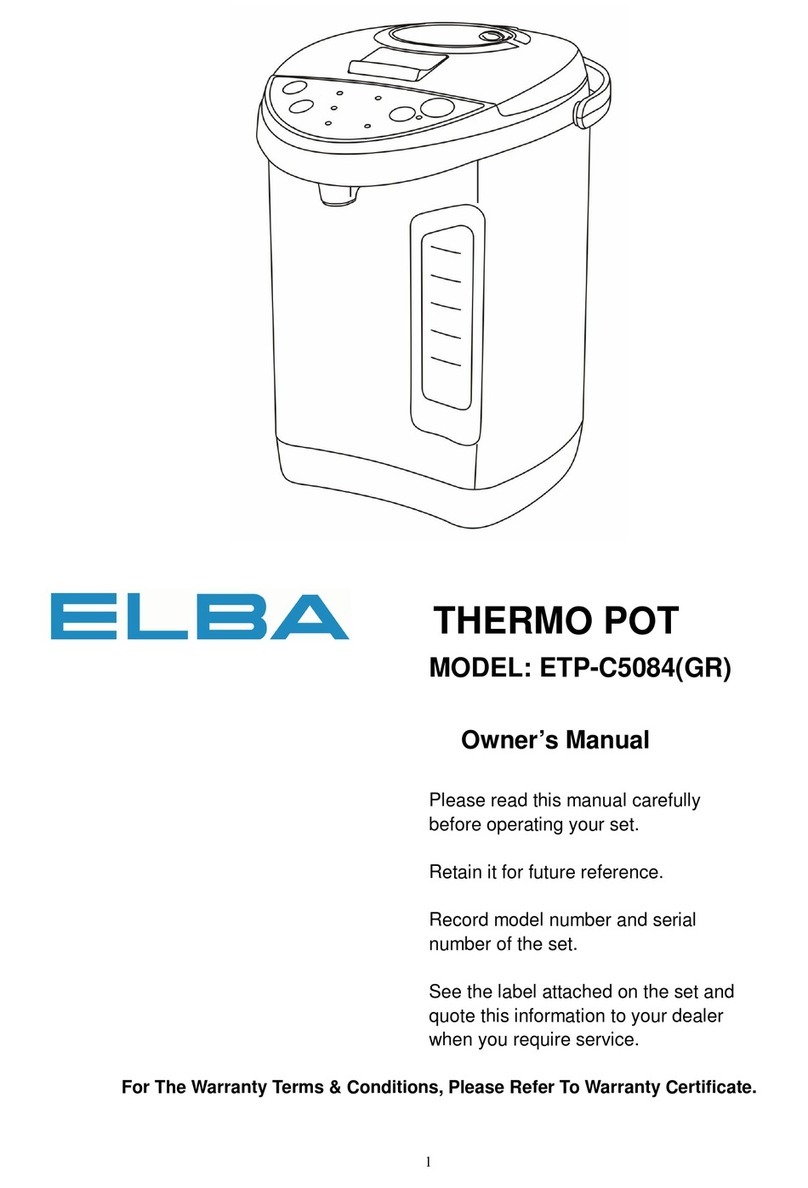
Elba
Elba ETP-C5084(GR) User manual
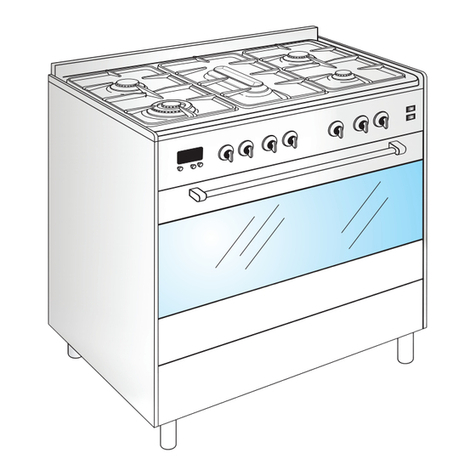
Elba
Elba EC 967F SS User manual
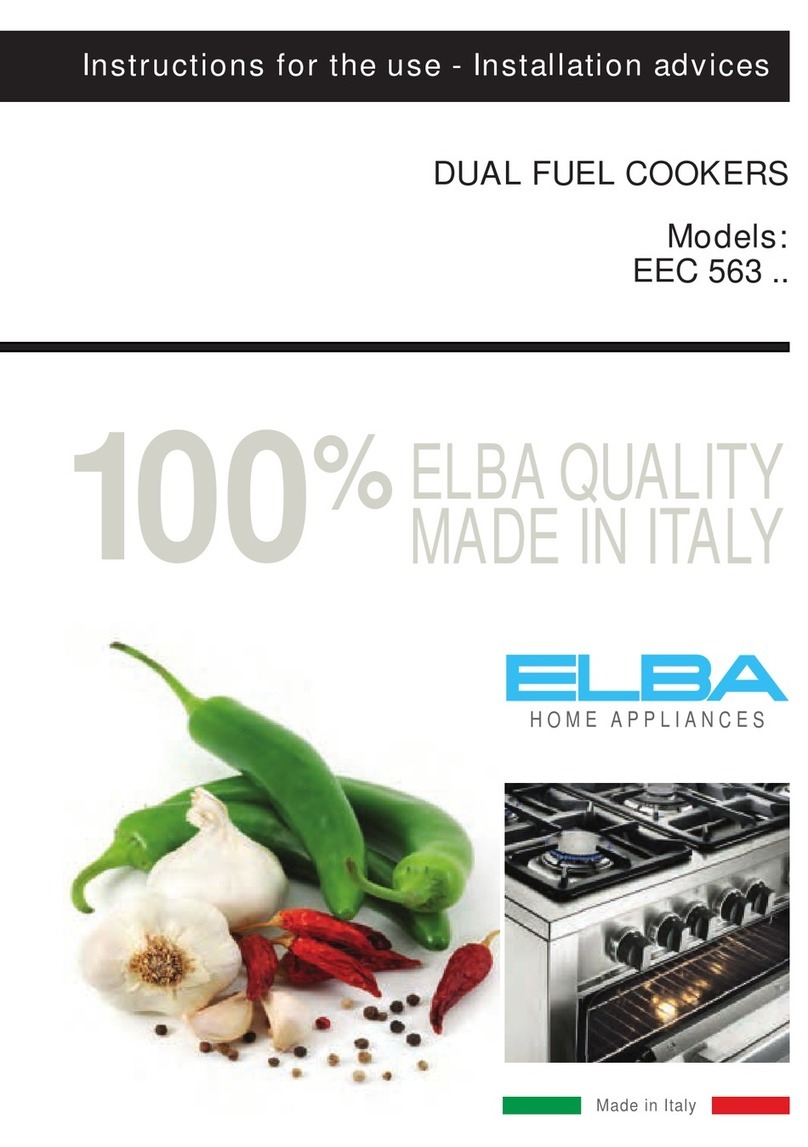
Elba
Elba EEC 563 series User manual
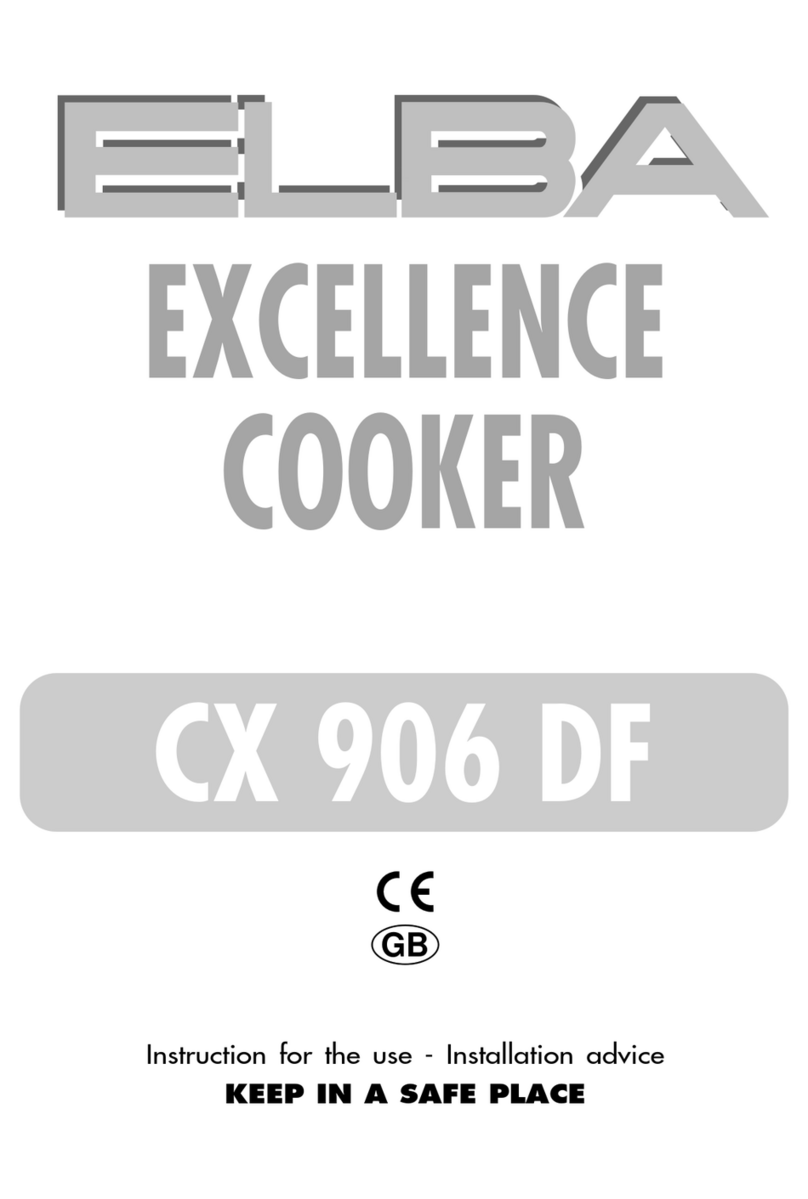
Elba
Elba CX 906 DF Technical manual

Elba
Elba EMC-N5017 User manual
